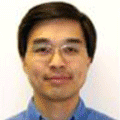Report of Prof. Wallace C. H. Choy from University of Hong Kong |
| Timeú║2014-06-26 21:09 |
 |
Wallace C. H. Choy
Wallace C. H. Choy received his PhD Degree in Electronic Engineering from the University of Surrey, UK in 1999. He then joined National Research Council of Canada as a member of research staff to work on optical device structures of polarization independent optical amplifiers tunable lasers and modulators. He joined Fujitsu at San Jose, US in 2001 to develope real-time wavelength tunable lasers and optical transmitter modules. He is now an associate professor of Department of Electrical and Electronic Engineering, the University of Hong Kong (HKU).
|
Topic: High Efficiency Organic Solar Cells with Plasmonic Metal Nanostructures
Abstract: A theoretical and experimental study of plasmonic organic solar cells with the metallic nanostructures is presented in this talk. From theoretical study, the physics of the absorption enhancement of the organic solar cell is explained by electromagnetic theory for optimizing the performance of plasmonic organic solar cells. Meanwhile, we have also experimental investigated the electrical and optical properties of plasmonic organic solar cells with various metallic nanostructures such as metallic nanoparticles and metallic nanogratings into different regions of the solar cells. We will also introduce novel low-temperature solution-based approaches to fabricate novel carrier transport layers and electrode for the emerging technologies of low-cost and large area photovoltaics.
Our results show that the incident photon to charge-carrier efficiency (IPCE) and current density (J)-voltage (V) characteristics are improved. The power conversion efficiency of organic solar cells can be enhanced by over 30% and the value of power conversion efficiency can reach about 9.2% depending on the metallic nanostructures, device structures, and the polymer materials. Details of the improvement will be discussed.
Time: June 30th (Monday), at 15:30
Locationú║Room 230 in the Building of DPSE
(By elan)
|
Readú║4955
|
